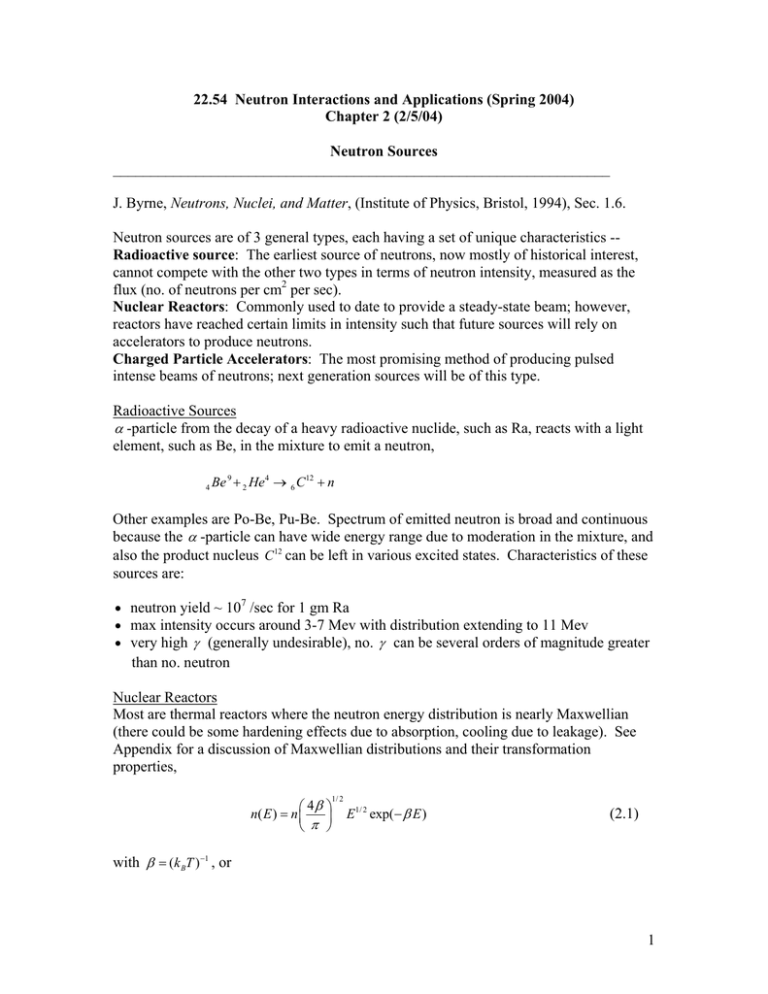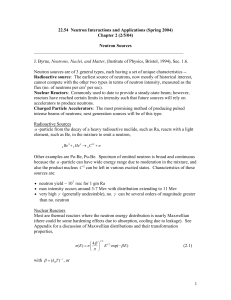Document 13031084
advertisement

22.54 Neutron Interactions and Applications (Spring 2004) Chapter 2 (2/5/04) Neutron Sources __________________________________________________________________ J. Byrne, Neutrons, Nuclei, and Matter, (Institute of Physics, Bristol, 1994), Sec. 1.6. Neutron sources are of 3 general types, each having a set of unique characteristics -- Radioactive source: The earliest source of neutrons, now mostly of historical interest, cannot compete with the other two types in terms of neutron intensity, measured as the flux (no. of neutrons per cm2 per sec). Nuclear Reactors: Commonly used to date to provide a steady-state beam; however, reactors have reached certain limits in intensity such that future sources will rely on accelerators to produce neutrons. Charged Particle Accelerators: The most promising method of producing pulsed intense beams of neutrons; next generation sources will be of this type. Radioactive Sources α -particle from the decay of a heavy radioactive nuclide, such as Ra, reacts with a light element, such as Be, in the mixture to emit a neutron, 4 Be9 + 2 He 4 → 6 C 12 + n Other examples are Po-Be, Pu-Be. Spectrum of emitted neutron is broad and continuous because the α -particle can have wide energy range due to moderation in the mixture, and also the product nucleus C12 can be left in various excited states. Characteristics of these sources are: • neutron yield ~ 107 /sec for 1 gm Ra • max intensity occurs around 3-7 Mev with distribution extending to 11 Mev • very high γ (generally undesirable), no. γ can be several orders of magnitude greater than no. neutron Nuclear Reactors Most are thermal reactors where the neutron energy distribution is nearly Maxwellian (there could be some hardening effects due to absorption, cooling due to leakage). See Appendix for a discussion of Maxwellian distributions and their transformation properties, 1/ 2 4β n( E ) = n π E1/ 2 exp(− β E) (2.1) with β = (k BT ) −1 , or 1 n (v ) = n 4 v 2 exp[−(v / vT ) 2 ] 3 v π T (2.2) with vT2 = 2 / mβ . The neutron flux φ (v) = vn(v) has its maximum at vmax = (3/ mβ )1/ 2 . It's distribution in wavelength λ , where λ = h / mv = 0.286 / E in A if E is in eV, is φ (λ ) = n 2λT4 λ5 exp(−λT2 / λ 2 ) (2.3) with λT = h /mvT , and λmax = 2 / 5λT . One can also write the flux as φ ( E ) = vn( E ) . General characteristics: 13 15 2 • typical thermal flux in the core ~10 -10 n/cm sec • normal core-shielding surface distance d is 300 cm (10'), suppose collimator aperture A is 1 cm2, A/d2 ~ 10-5, this means with φ ~ 1014 one has 109 n/cm2sec at the end of the collimator 2 o • one can shift the position of max flux by inserting either a cold (liquid H at 20 K) or o hot (block of Be heated to 1200 C by nuclear radiation) moderator next to the beamport, this will give an intensity gain of about an order of magnitude Charge-Particle Accelerators This is inherently a pulsed source in that neutrons are produced in bursts which are most suited to time-of-flight measurements. Characteristics are: • early experiments used cyclotron to bombard Be targets with 10 MeV deuterons, 4 Be9 + 1 H 2 → 5 B10 + n peak intensity ~ 3x1012 n/sec at 103 pulses/sec; pulse width ~ 10 µ sec • synchrocyclotron can accelerate protons up to 400 MeV for bombardment of high Z targets (Pb, W, or U), neutrons produced by spallation reaction (up to 50 neutrons per proton), intensity can reach ~ 2x1019 n/sec at 60 pulses/sec, pulse width ~ 25nsec • linear electron accelerator - high energy electrons generate x-rays in heavy target as well as ( (γ , n) reactions in Be (for example); with U target get photofission in addition. A 27 MeV accelerator can produce 1017-1018 n/sec. With a facility like the MIT linac at Middleton one can go up to 400 MeV. 2 Appendix We begin with the Maxwellian distribution in velocity as a probability distribution in velocity space. It is therefore a function in three dimensions (since the velocity v is a three-dimensional vector). We usually choose to express this function in cartesian coordinates (vx , v y , vz ) , or spherical coordinates (v, Ω) , where v is the speed (the magnitude of the velocity) and Ω is a two-dimensional vector in angular space. It is useful to keep in mind that Ω is a vector on the surface of a unit sphere, pointing in the direction of the velocity. Thus it can be specified in terms of a polar angle θ and an azimuthal angle ϕ (see Fig.1-2 in Chap 1). A simple way to remember the Maxwellian distribution is to write down the expression for the distribution of momentum vector p = mv , of a particle with mass m and velocity v moving in a medium at temperature T, β M ( p) = 2π m 3/ 2 exp(− β p / 2m) 2 (2.A.1) where β = 1/ k BT , k B being Boltzmann's constant (1.38x10-16 erg/oK). This function is normalized to unity as a probability distribution should, ∫d 3 pM ( p ) = 1 (2.A.2) In cartesian or spherical coordinates this three-dimensional integral becomes ∞ ∞ ∞ ∫ dp ∫ dp ∫ dp M ( p , p , p ) = 1 x −∞ y −∞ z x y z (2.A.3) −∞ ∞ ∫ p dp ∫ d ΩM ( p,Ω) = 1 2 (2.A.4) 0 Notice, however, that M is only a function of the magnitude of the momentum vector. The fact that the Maxwellian is independent of the polar and azimuthal angles makes it a spherically symmetric function which is considerably simpler than anything that involves angular distributions. For one thing, the angular integration in (2.A.4) can be carried out, giving a factor of 4π , ∞ ∫ p dpM ( p) = 1/ 4π 2 (2.A.5) 0 In (2.A.5) M(p) is the still the same function given in (2.A.1), we just write the argument as the magnitude to emphasize that the function depends only the scalar variable p. 3 It is a good exercise, especially for the students in need of some practice, to verify the above normalizations by direct integration. The integrals all reduce to the following: ∞ ∫y e dy = Γ(1/ 2) = π −1/ 2 − y (2.A.6) 0 ∞ ∫y 0 1 e dy = Γ(3/ 2) = Γ(1/ 2) = π / 2 2 1/ 2 − y (2.A.7) What we have shown is that the one-dimensional Maxwellian distribution of the momentum (magnitude, therefore a scalar) is Suppose we wish to decompose the 3D distribution M ( p ) into a product of lowerdimensional distributions. In general we can write M ( p ) = M ( p ) P (Ω ) (2.A.8) where M(p) is a one-dimensional Maxwellian distribution of the momentum magnitude (a scalar) and P is an angular distribution of the direction of the momentum vector p . Since M ( p ) is spherically symmetric, it follows that the angular distribution is uniform over the unit sphere, or P (Ω) = 1/ 4π (2.A.9) Inserting (2.A.1) and (2.A.9) into (2.A.8) we obtain β M ( p ) = 4π 2π m 3/ 2 exp( − β p 2 / 2m) (2.A.10) The normalization (2.A.4) requires ∞ 2 ∫ d ΩP(Ω)∫ p dpM ( p) = 1 (2.A.11) 0 Obviously the angular part is satisfied. One can check to see that the radial part, with M(p) given by (2.A.10) is also satisfied. We now define another one-dimensional momentum distribution G(p) as G ( p) = p 2 M ( p) (2.A.12) which, in view of (2.A.11) has the normalization 4 ∞ ∫ G( p)dp = 1 (2.A.13) 0 The significance of G(p) is that it is very convenient to use it to obtain other onedimensional Maxwellian distributions, such as the distributions in energy E, where E = p 2 / 2m = mv 2 / 2 , and in speed v, where p = mv. The transformation between G(p) and the other one-dimensional distributions is simply G ( p ) = n( E ) dE , or n( E ) = G ( p) dp / dE (2.A.14) One therefore finds the Maxwellian distribution in energy to be 1/ 2 β n( E ) = 2 β π E1/ 2 exp(− β E ) (2.A.15) ∞ with normalization ∫ n( E )dE = 1 0 Similarly, for the distribution in particle speed v, G ( p ) = n(v)dv (2.A.16) which gives 1/ 2 2 n (v ) = π ( β m) 3/ 2 v 2 exp(− β mv 2 / 2) (2.A.17) ∞ with ∫ n(v)dv = 1 (2.A.18) 0 5





